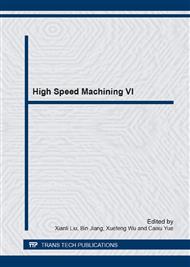p.633
p.639
p.644
p.649
p.654
p.660
p.666
p.672
p.678
The Tool Path Planning and Simulation Analysis of Surface Flank Milling for Titanium Impeller Blade
Abstract:
The impeller is an important typical part of machinery and equipment industry, and is widely used in energy and power, aerospace, petrochemical, metallurgy and other fields. However, due to the complex shape of the impeller blades, forming more difficult. Flank milling have many advantages, such as forming good accuracy, high efficiency. Therefore, in the paper will choose flank milling for impeller milling. Based on the properties of titanium alloy material and the external characteristics of the impeller blades, proposed control method for machining distortion of impeller blades. Using three offset method to calculate the initial tool position of cylindrical cutter flank milling undevelopable ruled surface, then calculate the initial tool position of cone ball cutter to plan tool path of milling. Through the VERICUT software to simulate the whole process of the impeller flank milling, in order to verify the tool path planning and determine the interference between the tool and the workpiece, the tool and the workpiece does not occur. Finally, through experiments to verify the feasibility of planning algorithm. The trajectory planning and simulation of flank milling titanium impeller blades are foundation of improvement the processing efficiency of the impeller blades and better surface quality.
Info:
Periodical:
Pages:
654-659
Citation:
Online since:
July 2014
Authors:
Price:
Сopyright:
© 2014 Trans Tech Publications Ltd. All Rights Reserved
Share:
Citation:


